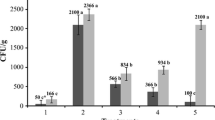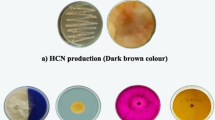Summary
Field plots were established in Indiana, Oregon, and Montana to evaluate the potential for biological control of various strains of bacteria as seed treatments to reduce the severity of take-all root, crown, and foot rot of wheat. The bacteria were grown in liquid broth Cas-amino acid broth media, mixed with finely ground peat, and applied to seed with methyl cellulose as a glue just before planting in field soils conducive for severe take-all. Autoclave-sterilized peat (minus bacteria) seed treatments increased take-all, immobilized Mn, and reduced plant vigor and grain yields. These effects were intensified when the pH of the natural peat was adjusted from 5.2 to 7.0 with CaCO3. The ability of the bacterial strains to counteract this peat-induced predisposition to take-all varied, and was influenced by planting site, genetic tolerance of the cultivar, and N treatment. Although the strains differed in their ability to suppress the peat-induced take-all, none of the isolates fully nullified the deleterious effects of the peat carrier. It is clear from this study that the carrier used with potential biological-contol agents may have a greater influence on disease than the biological agent.
Similar content being viewed by others
References
Akers HA (1983) Multiple hydroxamic acid microbial iron chelators (siderophores) in soils. Soil Sci 135:156–176
Asher MJC, Shipton PJ (1981) Biology and control of take-all. Academic Press, New York London
Cook RJ, Rovira AD (1976) The role of bacteria in the biological control of Gaeumannomyces graminis by suppressive soils. Soil Biol Biochem 8:269–273
Cline GR, Powell PE, Szaniszlo PJ, Reid CPP (1983) Comparison of the abilities of hydroxamic and other natural organic acids to chelate iron and other ions in the soil. Soil Sci 136:145–157
Garrett SD (1981) Introduction. In: Asher MJC, Shipton PJ (eds) Biology and control of take-all. Academic Press, New York London, pp 1–14
Hodgson JF (1963) Chemistry of the micronutrient elements in soils. Adv Agron 15:119
Huber DM (1972) Spring versus fall nitrogen fertilization and takeall of spring wheat. Phytopathology 62:434–436
Huber DM (1977) The occurrence of take-all decline in Indiana wheat soils. Proc Am Phytopathol Soc 4:148
Huber DM (1980) Role of nutrients in defense, chapter 23. In: Horsfall JG, Cowling EB (eds) Plant pathology: An advanced treatise, vol 5. Academic Press, New York London, pp 381–406
Huber DM (1981) The role of nutrients and chemicals. In: Asher MJC, Shipton PJ (eds) Biology and control of take-all. Academic Press, New York London, pp 317–342
Huber DM (1989) The role of nutrition in the take-all disease of wheat and other small grains. APS Press, St Paul, Minn (in press)
Huber DM, Mburu DN (1983) The relationship of rhizosphere bacteria to disease tolerance, the form of N, and amelioration of take-all with manganese. Proc 4th Int Congr Plant Pathol, University of Melbourne, Australia
Huber DM, Painter CC, McKay HC, Peterson DL (1968) Effect of nitrogen fertilization on take-all of winter wheat. Phytopathology 58:1470–1472
Huber DM, Watson RD (1974) Nitrogen form and plant disease. Annu Rev Phytopathol 12:139–165
Huber DM, Warren HL, Nelson DW, Tsai CY (1977) Nitrification inhibitors, new tools for food production. BioScience 27:523–529
Huber DM, Warren HL, Nelson DW, Tsai CY, Shaner GE (1980) Response of winter wheat to inhibiting nitrification of fall-applied nitrogen. Agron J 72:632–638
Huber DM, Wilhelm NS (1988) The role of manganese in disease resistance. In: Graham RD, Hannam RJ, Uren NC (eds) Manganese in soils and plants. Kluwer, Dordrecht, pp 155–173
Leong J (1986) Siderophores: Their biochemistry and possible role in the biocontrol of plant pathogens. Annu Rev Phytopathol 24:187–209
Rosemann TS, Phillips JD, Huber DM (1988) Microelement immobilization predisposes wheat to take-all. Phytopathology 78:1504
Shipton PJ (1981) Variation in host susceptibility. In: Asher MJC, Shipton PJ (eds) Biology and control of take-all. Academic Press, New York London, pp 219–236
Smiley RW, Cook RJ (1971) Influence of nitrogen fertilizers on rhizosphere pH and take-all of wheat caused by Ophiobolus graminis. Phytopathology 61:911–912
Steele RGD, Torrey JH (1980) Principles and procedures of statistics, 2nd edn. McGraw-Hill, New York
Stevenson FJ (1986) The micronutrient cycle. In: Stevenson FJ (ed) Cycles of soil. Wiley, New York
Weise MV (1977) Compendium of wheat diseases. Am Phytopathol Soc, St Paul, Minn
Weller DM (1983) Colonization of wheat roots by a fluorescent Pseudomonad suppressive to take-all. Phytopathology 73:1548 -1553
Weller DM (1985) Application of a rapid screening test for selection of bacteria suppressive to take-all of wheat. Plant Dis 69:710–713
Weller DM, Cook RJ (1983) Suppression of take-all of wheat by seed treatment and fluorescent pseudomonads. Phytopathology 73:463–469
Yarham DJ (1981) Practical aspects of epidemiology and control. In: Asher MJC, Shipton PJ (eds) Biology and control of take-all. Academic Press, New York London, pp 353–385
Author information
Authors and Affiliations
Rights and permissions
About this article
Cite this article
Huber, D.M., El-Nasshar, H., Moore, L.W. et al. Interaction between a peat carrier and bacterial seed treatments evaluated for biological control of the take-all diseases of wheat (Triticum aestivum L.). Biol Fert Soils 8, 166–171 (1989). https://doi.org/10.1007/BF00257761
Received:
Issue Date:
DOI: https://doi.org/10.1007/BF00257761




